43.
EGYPTIAN HIEROGLYPHIC WRITING1
ByE.A.WALLIS BUDGEn/an/an/an/a
The ancient Egyptians expressed their ideas in writing by means of a large number of picture signs which are commonly called Hieroglyphics. They began to use them for this purpose more than seven thousand years ago, and they were employed uninterruptedly until about B. C. 100, that is to say, until nearly the end of the rule of the Ptolemies over Egypt. It is hardly probable that the hieroglyphic system of writing was invented in Egypt, and the evidence on this point now accumulating indicates that it was brought there by certain invaders who came from north-east or central Asia; they settled down in the valley of the Nile at some place between Memphis on the north and Thebes on the south, and gradually established their civilization and religion in their new home. Little by little the writing spread to the north and to the south, until at length hieroglyphics were employed, for state purposes at least, from the coast of the Mediterranean to the most southern portion of the Island of Meroë, that is to say, over a tract of country more than 2000 miles long. A remarkable peculiarity of Egyptian hieroglyphics is the slight modification of form which they suffered during a period of thousands of years, a fact due, no doubt, partly to the material upon which the Egyptians inscribed them, and partly to a conservatism begotten of religious convictions. The Babylonian and Chinese picture characters became modified at so early a period that some thousands of years before Christ, their original forms were lost. This reference to the modified forms of hieroglyphics brings us at once to the mention of the various ways in which they were written in Egypt, i. e., to the three different kinds of Egyptian writing.
The oldest form of writing is the hieroglyphic, in which the various objects, animate and inanimate, for which the characters stand are depicted as accurately as possible. . . .
Hieroglyphics were cut in stone, wood, and other materials with marvellous accuracy, at depths varying from

of an inch to 1 inch; the details of the objects represented were given either by cutting or by painting in colours. In the earliest times the mason must have found it easier to cut characters into the stone than to sculpture them in relief; but it is probable that the idea of preserving carefully what had been
inscribed also entered his mind, for frequently when the surface outline of a character has been destroyed sufficient traces remain in the incuse portion of it for purposes of identification. Speaking generally, celestial objects are coloured blue, as also are metal vessels and instruments; animals, birds, and reptiles are painted as far as possible to represent their natural colours; the Egyptian man is painted red, and the woman yellow or a pinky-brown colour; and so on. . . .
Picture signs or hieroglyphics were employed for religious and state purposes from the earliest to the latest times, and it is astonishing to contemplate the labour which must have been expended by the mason in cutting an inscription of any great length, if every character was well and truly made. Side by side with cutters in stone carvers in wood must have existed, and for a proof of the skill which the latter class of handicraftsmen possessed at a time which must be well nigh pre-dynastic, the reader is referred to the beautiful panels in the Gizeh Museum which have been published by Mariette. . . . But the Egyptians must have had need to employ their hieroglyphics for other purposes than inscriptions which were intended to remain in one place, and the official documents of state, not to mention the correspondence of the people, cannot have been written upon stone or wood. At a very early date the papyrus plant was made into a sort of paper upon which were written drafts of texts which the mason had to cut in stone, official documents, letters, etc. The stalk of this plant, which grew to the height of twelve or fifteen feet, was triangular, and was about six inches in diameter in its thickest part. The outer rind was removed from it, and the stalk was divided into layers with a flat needle; these layers were laid upon a board, side by side, and upon these another series of layers was laid in a horizontal direction, and a thin solution of gum was then run between them, after which both series of layers were pressed and dried. The number of such sheets joined together depended upon the length of the roll required. The papyrus rolls which have come down to us vary greatly in length and width; the finest Theban papyri are about seventeen inches wide, and the longest roll yet discovered is the great Papyrus of Rameses III, which measures one hundred and thirty-five feet in length. On such rolls of papyrus the Egyptians wrote with a reed, about ten inches long
and one-eighth of an inch in diameter, the end of which was bruised to make the fibres flexible, and not cut; the ink was made of vegetable substances, or of coloured earths mixed with gum and water.
Now it is evident that the hieroglyphics traced in outline upon papyrus with a comparatively blunt reed can never have had the clearness and sharp outlines of those cut with metal chisels in a hard substance; it is also evident that the increased speed at which government orders and letters would have to be written would cause the scribe, unconsciously at first, to abbreviate and modify the picture signs, until at length only the most
salient characteristics of each remained. And this is exactly what happened. Little by little the hieroglyphics lost much of their pictorial character, and degenerated into a series of signs which went to form the cursive writing called Hieratic. It was used extensively by the priests in copying literary works in all periods, and though it occupied originally a subordinate position in respect of hieroglyphics, especially as regards religious texts, it at length became equal in importance to hieroglyphic writing. The following example of hieratic writing is taken from the Prisse Papyrus upon which at a period about B. C. 2600 two texts, containing moral precepts which were composed about one thousand years earlier, were written.
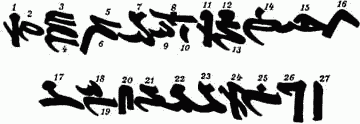
Now if we transcribe these into hieroglyphics we obtain the following:
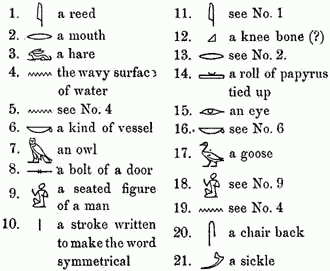
On comparing the above hieroglyphics with their hieratic equivalents it will be seen that only long practice would enable the reader to identify
quickly the abbreviated characters which he had before him; the above specimen of hieratic is, however, well written and is relatively easy to read. In the later times, i. e., about B. C. 900, the scribes invented a series of purely arbitrary or conventional modifications of the hieratic characters and so a new style of writing, called Enchorial or Demotic, came into use; it was used chiefly for business or social purposes at first, but at length copies of the "Book of the Dead" and lengthy literary compositions were written in it. In the Ptolemaic period Demotic was considered to be of such importance that whenever the text of a royal decree was inscribed upon a stele which was to be set up in some public place and was intended to be read by the public in general, a version of the said decree, written in the Demotic character, was added. . . .
Hieroglyphic characters may be written in columns or in horizontal lines, which are sometimes to be read from left to right and sometimes from right to left. There was no fixed rule about the direction in which the characters should be written, and as we find that in inscriptions which are cut on the sides of a door they usually face inwards, i. e., towards the door, each group thus facing the other, the scribe and sculptor needed only to follow their own ideas in the arrangement and direction of the characters, or the dictates of symmetry. To ascertain the direction in which an inscription is to be read we must observe in which way the men, and birds, and animals face, and then read towards them. . . .
Hieratic is usually written in horizontal lines which are to be read from right to left, but in some papyri dating from the XIIth dynasty the texts are arranged in short columns.
Before we pass to the consideration of the Egyptian Alphabet, syllabic signs, etc., it will be necessary to set forth briefly the means by which the power to read these was recovered, and to sketch the history of the decipherment of Egyptian hieroglyphics in connection with the Rosetta Stone. . . .
The Rosetta Stone was found by a French artillery officer called Boussard, among the ruins of Fort Saint Julian, near the Rosetta mouth of the Nile, in 1799, but it subsequently came into the possession of the British Government at the capitulation of Alexandria. It now stands at the southern end of the great Egyptian Gallery in the British Museum. The top and right hand bottom corner of this remarkable object have been broken off, and at the present the texts inscribed upon it consist of fourteen lines of hieroglyphics, thirty-two lines of demotic, and fifty-four lines of Greek. It measures about 3 ft. 9 in. x 2 ft. 4½ in. x 11 in. on the inscribed side.
The Rosetta Stone records that Ptolemy V. Epiphanes, king of Egypt from B. C. 205 to B. C. 182, conferred great benefits upon the priesthood, and set aside large revenues for the maintenance of the temples, and
remitted the taxes due from the people at a period of distress, and under took and carried out certain costly engineering works in connection with the irrigation system of Egypt. In gratitude for these acts the priesthood convened a meeting at Memphis, and ordered that a statue of the king should be set up in every temple of Egypt, that a gilded wooden statue of the king placed in a gilded wooden shrine should be established in each temple, etc.; and as a part of the great plan to do honour to the king it was ordered that a copy of the decree, inscribed on a basalt stele in hieroglyphic, demotic, and Greek characters, should be set up in each of the first, second, and third grade temples near the king’s statue. The provisions of this decree were carried out in the eighth year of the king’s reign, and the Rosetta Stone is one of the stelae which, presumably, were set up in the great temples throughout the length and breadth of the land. But the importance of the stone historically is very much less than its value philologically, for the decipherment of the Egyptian hieroglyphics is centred in it, and it formed the base of the work done by scholars in the past century which has resulted in the restoration of the ancient Egyptian language and literature.
It will be remembered that long before the close of the Roman rule in Egypt the hieroglyphic system of writing had fallen into disuse, and that its place had been taken by demotic, and by Coptic, that is to say, the Egyptian language written in Greek letters; the widespread use of Greek and Latin among the governing and upper classes of Egypt also caused the disappearance of Egyptian as the language of state. The study of hieroglyphics was prosecuted by the priests in remote districts probably until the end of the Vth century of our era, but very little later the ancient inscriptions had become absolutely a dead letter, and until the beginning of the present century there was neither an Oriental nor a European who could either read or understand a hieroglyphic inscription. Many writers pretended to have found the key to the hieroglyphics, and many more professed, with a shameless impudence which it is hard to understand in these days, to translate the contents of the texts into a modern tongue. Foremost among such pretenders must be mentioned Athanasius Kircher who, in the XVIIth century, declared that he had found the key to the hieroglyphic inscriptions; the translations which he prints in his Oedipus Aegyptiacus are utter nonsense, but as they were put forth in a learned tongue many people at the time believed they were correct. More than half a century later the Comte de Pahlin stated that an inscription at Denderah was only a translation of Psalm C., and some later writers believed that the Egyptian inscriptions contained Bible phrases and Hebrew compositions. In the first half of the XVIIIth century Warburton appears to have divined the existence of alphabetic characters in Egyptian, and had he possessed the necessary linguistic training it is quite possible that he would have done some useful work
in decipherment. Among those who worked on the right lines must be mentioned de Guignes, who proved the existence of groups of characters having determinatives, and Zoëga, who came to the conclusion that the hieroglyphics were letters, and what was very important, that the car-touches, i. e., the ovals which occur in the inscriptions and are so called because they resemble cartridges, contained royal names. In 1802 Aker-blad, in a letter to Silvestre de Sacy, discussed the demotic inscription on the Rosetta Stone, and published an alphabet of the characters. But Akerblad never received the credit which was his due for this work, for although it will be found, on comparing Young’s "Supposed Enchorial Alphabet" printed in 1818 with that of Akerblad printed in 1802, that fourteen of the characters are identical in both alphabets, no credit is given to him by Young. Further, if Champollion’s alphabet, published in his Lettre à M. Dacier, Paris, 1822, be compared with that of Akerblad, sixteen of the characters will be found to be identical; yet Champollion, like Young, seemed to be oblivious of the fact.
With the work of Young and Champollion we reach firm ground. A great deal has been written about the merits of Young as a decipherer of the Egyptian hieroglyphics, and he has been both over-praised and over-blamed. He was undoubtedly a very clever man and a great linguist, even though he lacked the special training in Coptic which his great rival Champollion possessed. In spit of this, however, he identified correctly the names of six gods, and those of Ptolemy and Berenice; he also made out the true meanings of several ideographs, the true values of six letters of the alphabet, and the correct consonantal values of three more. This he did some years before Champollion published his Egyptian alphabet, and as priority of publication (as the late Sir Henry Rawlinson found it necessary to say with reference to his own work on cuneiform decipherment) must be accepted as indicating priority of discovery, credit should be given to Young for at least this contribution towards the decipherment. No one who has taken the pains to read the literature on the subject will attempt to claim for Young that the value of his work was equal to that of Champollion, for the system of the latter scholar was eminently scientific, and his knowledge of Coptic was wonderful, considering the period when he lived. Besides this the quality of his hieroglyphic work was so good, and the amount of it which he did so great, that in those respects the two rivals ought not to be compared. He certainly knew of Young’s results, and the admission by him that they existed would have satisfied Young’s friends, and in no way diminished his own merit and glory.
In the year 1815 Mr. J. W. Bankes discovered on the Island of Philae a red granite obelisk and pedestal which were afterwards removed at his expense by G. Belzoni and set up at Kingston Hall in Dorsetshire. The obelisk is inscribed with one column of hieroglyphics on each side, and
the pedestal with twenty-four lines of Greek. In 1822 Champollion published an account of this monument in the Revue encyclopédique for March, and discussed the hieroglyphic and Greek inscriptions upon it. The Greek inscription had reference to a petition of the priests of Philae made to Ptolemy, and his wife Kleopatra, and his sister also called Kleopatra, and these names of course occur in it. Champollion argued that if the hieroglyphic inscription has the same meaning as the Greek, these names must also occur in it. Now the only name found on the Rosetta Stone is that of Ptolemy which is, of course, contained in a cartouche, and when Champollion examined the hieroglyphic inscription on the Philae obelisk, he not only found the royal names there, enclosed in cartouches, but also that one of them was identical with that which he knew from the Greek of the Rosetta Stone to be that of Ptolemy. He was certain that this name was that of Ptolemy, because in the Demotic inscription on the Rosetta Stone the group of characters which formed the name occurred over and over again, and in the places where, according to the Greek, they ought to occur. But on the Philae Obelisk the name Kleopatra is mentioned, and in both of the names of Ptolemy and Kleopatra the same letters occur, that is to say L and P; if we can identify the letter P we shall not only have gained a letter, but be able to say at which end of the cartouches the names begin. Now writing down the names of Ptolemy and Kleopatra as they usually occur in hieroglyphics we have:

Let us however break the names up a little more and arrange the letters under numbers thus:—
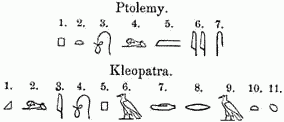
We must remember too that the Greek form of the name Ptolemy is Ptolemaios. Now on looking at the two names thus written we see at a glance that letter no. 5 in one name and no. 1 in the other are identical,
and judging by their position only in the names they must represent the letter P; we see too that letter no. 2 in one name and no. 4 in the other are also identical, and arguing as before from their position they must represent the letter L. We may now write down the names thus:—

As only one of the names begin with P, that which begins with that letter must be Ptolemy. Now letter no. 4 in one name, and letter no. 3 in the other are identical, and also judging by their position we may assign it in each name the value of some vowel sound like O, and thus get:—

But the letter between P and O in Ptolemy must be T, and as the name ends in Greek with S, the last letter in hieroglyphics must be S, so we may now write down the names thus:—

Now if we look, as Champollion did, at the other ways in which the name of Kleopatra is written we shall find that instead of the letter no. 7 we sometimes have the letter no. 2 which we already know to be T, and as in the Greek form of the name this letter has an A before it, we may assume that no.

the initial letter must, of course, be K. We may now write the names thus:—

The sign no. 3 in the name Kleopatra represents some vowel sound like E, and this sign doubled (no. 6) represents the vowels AI in the name Ptolemaios; but as no. 6 represents EE, or Î, that is to say I pronounced in the Continental fashion, the O of the Greek form has no equivalent in hieroglyphics. That leaves us only the signs no. 5 in Ptolemaios and 8 and 11 in Kleopatra to find values for. Young had proved that the double sign T and 11 always occurred at the ends of the names of goddesses, and that it was a feminine termination; as the Greek kings and queens of Egypt were honoured as deities, this termination was added to the names of royal ladies also. This disposes of the sign no. 11, and the letters no. 5 and no. 8 can be nothing else but M and R. So we may now write:—
PTOLMIS, i. e., Ptolemy,
KLEOPATRA, i. e., Kleopatra. . . .
Every hieroglyphic character is a picture of some object in nature, animate, or inanimate, and in texts many of them are used in more than one way. The simplest use of hieroglyphics is, of course, as pictures. . . . But hieroglyphics may also represent ideas, e. g., a wall falling down sideways represents the idea of "falling"; a hall in which deliberations by wise men were made represents the idea of "counsel"; an axe represents the idea of a divine person or a god; a musical instrument represents the idea of pleasure, happiness, joy, goodness, and the like. Such are called ideographs. Now every picture of every object must have had a name, or we may say that each picture was a word-sign; a list of all these arranged in proper order would have made a dictionary in the earliest times. But let us suppose that at the period when these pictures were used as pictures only in Egypt, or wherever they first appeared, the king wished to put on record that an embassy from some such and such a neighbouring potentate had visited him with such and such an object, and that the chief of the embassy, who was called by such and such a name, had brought him rich presents from his master. Now the scribes of the period could, no doubt, have reduced to writing an account of the visit, without any very great difficulty, but when they came to record the name of the distinguished visitor, or that of his master, they would not find this to be an easy matter. To have written down the name they would be obliged to make use of a number of hieroglyphics or picture characters which represented most closely the sound of the name of the envoy, without the least regard to their meaning as pictures, and, for the moment, the picture characters would have represented sounds only. These scribes must have done the same had they been ordered to make a
list of the presents which the envoy had brought for their royal master. Passing over the evident anachronism let us call the envoy "Ptolemy," which name we may write, as in the preceding chapter, with the signs:—

Now no. 1 represents a door, no. 2 a cake, no. 3 a knotted rope, no. 4 a lion, no. 5 (uncertain), no. 6 two reeds, and no. 7 a chairback; but here each of these characters is employed for the sake of its sound only.
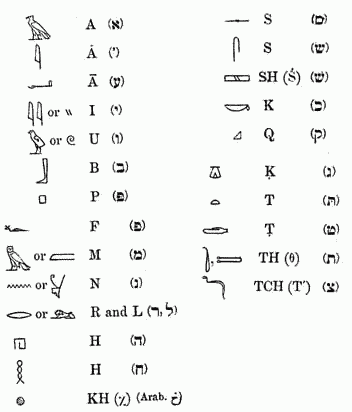 EGYPTIAN ALPHABET
EGYPTIAN ALPHABET
The need for characters which could be employed to express sounds only caused the Egyptians at a very early date to set aside a considerable number of picture signs for this purpose, and to these the name of phonetics has been given. Phonetic signs may be either syllabic or alphabetic, e. g., peh, mut, maāt, χeper, which are syllabic, and p, b, m, r, k, which are alphabetic. Now the five alphabetic signs just quoted represent as pictures, a door, a foot and leg, an owl, a mouth, and a vessel respectively, and each of these objects no doubt had a name; but the question naturally arises how they came to represent single letters? It seems that the sound of the first letter in the name of an object was given to the picture or character represented it, and henceforward the character bore that phonetic value. Thus the first character P, represents a door made of a number of planks of wood upon which three crosspieces are nailed. There is no word in Egyptian for door, at all events in common use, which begins with P, but, as in Hebrew, the word for door must be connected with the root "to open";
now the Egyptian word for "to open" is pt[a]h and as we know that the first character in that word has the sound Of P and of no other letter, we may reasonably assume that the Egyptian word for "door" began with P. The third character M represents the horned owl, the name of which is preserved for us in the Coptic word mûlotch; the first letter of this word begins with M, and therefore the phonetic value of the owl sign is M. In the same way the other letters of the Egyptian alphabet were derived, though it is not always possible to say what the word-value of a character was originally. In many cases it is not easy to find the word-values of an alphabetic sign, even by reference to Coptic, a fact which seems to indicate that the alphabetic characters were developed from word-values so long ago th
at the word-values themselves have passed out of the written language. Already in the earliest dynastic inscriptions known to us hieroglyphic characters are used as pictures, ideographs and phonetics side by side, which proves that these distinctions must have been invented in pre-dynastic times.
The Egyptian alphabet has a great deal in common with the Hebrew and other Semitic dialects in respect of the guttural and other letters, peculiar to Oriental peoples, and therefore the Hebrew letters have been added to shew what I believe to be the general values of the alphabetic signs. It is hardly necessary to say that differences of opinion exist among scholars as to the method in which hieroglyphic characters should be transcribed into Roman letters, but this is not to be wondered at considering that the scientific study of Egyptian is only about eighty years old, and that the whole of the literature has not yet been published.
Some ideographs have more than one phonetic value, in which case they arc called polyphones; and many ideographs representing entirely different objects have similar values, in which case they are called homophones.
As long as the Egyptians used picture writing pure and simple their meaning was easily understood, but when they began to spell their words with alphabetic signs and syllabic values of picture signs, which had no reference whatever to the original meaning of the signs, it was at once found necessary to indicate in some way the meaning and even sounds of many of the words so written; this they did by adding to them signs which are called determinatives. It is impossible to say when the Egyptians first began to add determinatives to their words, but all known hieroglyphic inscriptions not pre-dynastic contain them, and it seems as if they must have been the product of pre-historic times. They, however, occur less frequently in the texts of the earlier than of the later dynasties.
Determinatives may be divided into two groups; those which determine a single species, and those which determine a whole class. The following determinatives of classes should be carefully noted:—
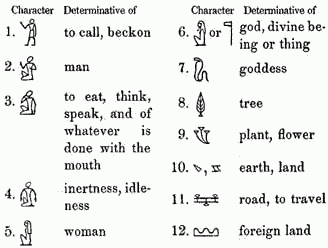
A few words have no determinative, and need none, because their meaning was fixed at a very early period, and it was thought unnecessary to add any; examples of such are henā "with," am "in," māk "verily" and the like. On the other hand a large number of words have one determinative, and several have more than one. Of words of one determinative the following are examples:
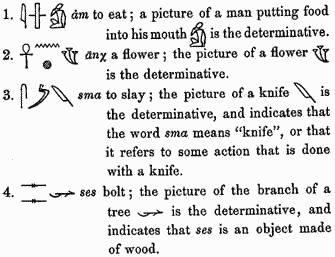
Of words of one or more determinatives the following is an example:—

Words may be spelt (1) with alphabetic characters wholly, or (2) with a mixture of alphabetic and syllabic characters; examples of the first class are:—
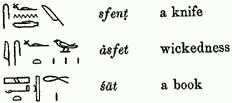
And examples of the second class are:—
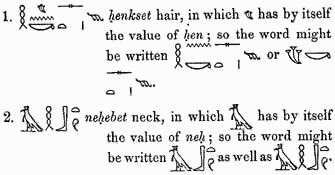
We may now take a short extract from the Tale of the Two Brothers, which will illustrate the use of alphabetic and syllabic characters and determinatives; the determinatives are marked by *; and the syllabic characters by †; the remaining signs are alphabetic. (N. B. There is no e in Egyptian.)
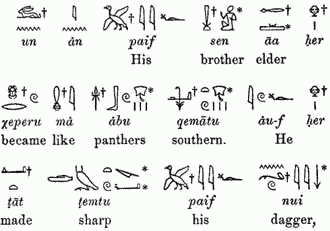
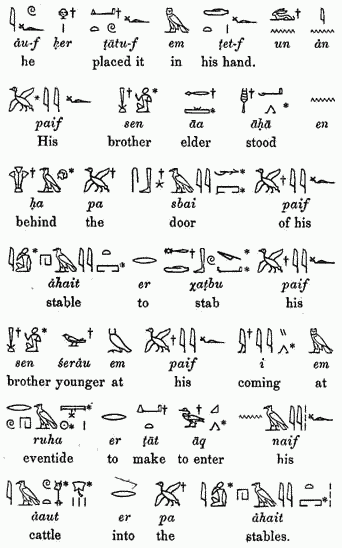
1